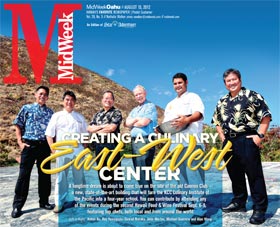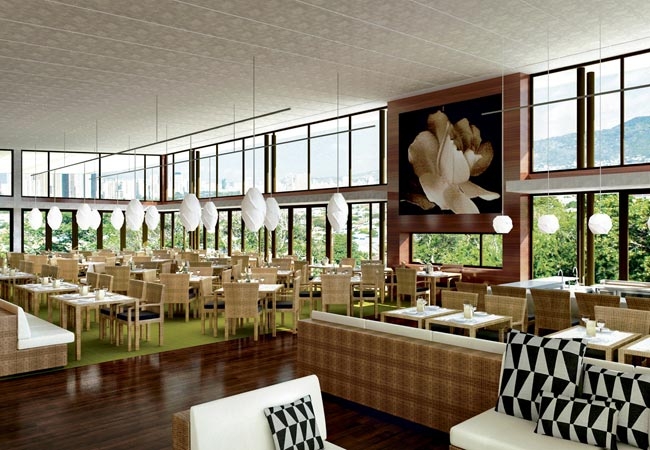Creating a Culinary East – West Center
It’s been a dream for many people for many years, and no an expanded, four-year Culinary Institute of the Pacific is nearly a reality. Attending the Hawaii Food & Wine Festival will bring that reality nearer.”
Standing atop the foundation of the old Cannon Club on the leeward side of Diamond Head, it is hard to envision the dreams John Morton, vice president for UH Community Colleges, has for the place.
Currently overturned old sofas, rainbow menageries of broken beer bottles and the makeshift tents of the itinerant occupy the space. Vandals’ tags mark every exposed surface of concrete, but through it all, Morton can still see the Pacific Ocean between the copses of overgrown kiawe and the final realization of a dream a decade-and-a-half old: the home of the new four-year cooking school, Culinary Institute of the Pacific.
It has become a bit of a urban legend to those in the hospitality industry, a vision that never quite gets realized, the little local school that will challenge the CIA (Culinary Institute of America) for growing the next generation of great Hawaii chefs. Finally, after land transfers from the federal government to the state to the university, the old officer’s club is prepared to transform the legend into reality.
“It has been 15 years, and people think it is never going to happen,” says Kelvin Ro, owner of Diamond Head Market & Grill and longtime backer of the school. “But we are going to break ground after the first of the year. It is all coming together, and this event really helps.”
The event Ro is referencing is the second annual Hawaii Food & Wine Festival, slated for Sept. 6-9 at various locations around Oahu. There will be wine tastings and cooking demos by 60 master chefs from around the world featuring our own local products.
“The great thing about the festival is we are bringing in a lot of chefs internationally, which will make Hawaii more visible,” says chef Roy Yamaguchi. “Food is an international language; food speaks to everybody. What we want to do is bring these chefs over, get people excited about Hawaii to better our economy here.
“Plus we make these chefs utilize our local ingredients – our fish, our meat.
They now have firsthand experience working with our products, and they can now go back to their country and talk about what they saw in Hawaii.”
While a portion of the proceeds from the festival go to finance the new school, perhaps the most valuable benefit to the students is they will work side-by-side with chefs they have only read about or seen on TV.
“It’s a win-win-win-win,” says chef Alan Wong, himself a graduate of CIP.
The state benefits from the extra tourism, explains Wong, farmers get to introduce their products to a global market, students get to have a transcendent experience and the school receives the operational funds it will need.
It also allows Hawaii to shake off some of the culinary stereotypes its been saddled with through the years.
“People think all we do is eat Spam out here, and the best thing I think the festival did was put the spotlight on Hawaii,” says Wong, who will be featured Sept. 7 at the Halekulani. “Not only on Hawaii, but it put the spotlight on all the ingredients we have to work with, the farmers and the ranchers, and we will have the best chefs in the world come to work with them.”
The focus of the festival on using local products dovetails perfectly with the emphasis that Morton is looking for in the expansion of the CIP.
“I want to see the school tie in with the College of Agriculture for the development of new product, the use of product, the creative side of aquaculture and agriculture that was not here before, and how do we use it,” says Morton, stressing the importance of perpetuating the fledgling farm-to-table movement in the Islands.
The school will serve as an advanced program for 200 students from the CIP campuses on four islands, allowing them to get the education that previously caused our local talent to flee to the Mainland.
The vision for the school seems very much to be an extrapolation of what guests will experience at the festival. When Wong and Yamaguchi were at the forefront of the Hawaii Regional Cuisine movement in the early ’90s they had to start from scratch, and they see the school as an important way to help keep the movement alive into the next generation.
“Hawaii is the melting pot of the Pacific, where East meets West,” says Wong. “So I think the biggest selling point of this school is continuing education and learning about the East, bringing in instructors from the Far East.
“The CIA has a good program. We don’t compete with them. When (chefs) come here, they should be learning East/West cooking, that is what we do here in Hawaii. No other program has the best of Japan, China and Korea. That is what we have here. It is like the East-West Center that Manoa has.”
The campus will be a 42,000-square-foot space containing not just classrooms but a full working restaurant and culinary amphitheater. It will serve to augment the current 50,000-square-foot facility at KCC, allowing students the opportunity that former graduates such as Wong never had.
“I would have gone on and furthered my education here,” says Wong, who, like most aspiring Hawaii chefs, was forced to head east to continue his maturation. “After graduating from CIP, I moved to the Mainland to go to the CIA and the Greenbrier. But if I would have had the opportunity to continue here, I would have, and then my story might have changed.”
Unfortunately for most graduates of the current two-year program, schools like the CIA are only dreams because of their prohibitive costs. According to Conrad Nonaka, CIP director for the entire UH system, for the hundreds who graduate from the program every year, maybe two can afford to attend prestigious Mainland institutes.
“We are going to be providing all those other students the opportunity to get that education right here in Hawaii,” says Nonaka, who graduated from the program back in the ’60s, when it was still housed in the Ala Wai clubhouse. “The future is really bright, with Hawaii being a leader in the hospitality industry, and now in the last 20 years we have our own cuisine,with the establishment of the Hawaiian Regional Cuisine movement. It is just ripe for the school to perpetuate that and build on that a stronger foundation for our students.”
The four-year degree is a must for the proper training of Hawaii’s future chefs, according to Yamaguchi, because running a restaurant is much more than just knowing how to prepare the meals.
“Chefs are not just people who cook; they need to know how to run a restaurant,” says Yamaguchi, who has more than 30 himself now. “A four-year school allows a student to become a whole human being, more well-rounded.”
Beyond management training, there are the finer points of cheffing that there is simply no time to cover in two years, such as charcuterie (preserving meats such as bacon and sausage), garde manger (the decorative arts) and butchery. This lack of skills not only deprives Hawaii residents of some delectable treats but impacts our economy as well.
“I talked to the venison guy from Molokai, and he said he was tapping out,” says Wong. “In order for these guys to make it, they have to sell the whole animal. If the chefs cannot break them down and use the entire animal, then those businesses are not going to survive.”
These skills will help to extend the desires of those involved in the farm-to-table movement, to tip the scale back toward more sustainable times. Yamaguchi likes to point out that Hawaii was 100 percent sustainable for centuries, but now we import more than 85 percent of our food.
Weaning ourselves from our import addiction won’t be easy, but neither has been building the educational engine to stop it. But just as the graffitied foundations of the Cannon Club soon will sprout a new opportunity for our young chefs, perhaps these young men and women can lead us back to the sustainability of old Hawaii.
“The advantage of education versus working in the industry is that education provides you the foundation, gives you the courage to step to the plate in working operations,” says Nonaka. “The way you really learn is out there in the business world, but going through the program gives you the foundation to step into any kitchen and really work it.”







